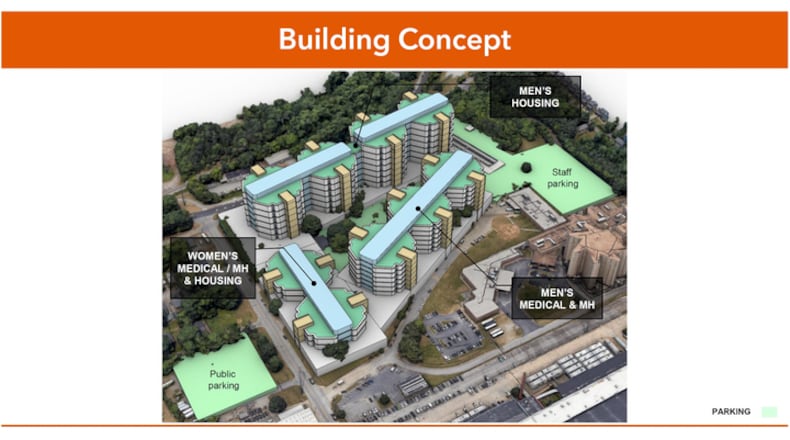The price of a new, larger jail in Fulton County will likely be almost $1.76 billion by the time it’s built in 2029, consultants told county commissioners Wednesday.
Even then the jail would not be fully operational for 18 months, but in 2031 it would not just house inmates but provide “robust wraparound services and enhanced staff facilities,” according to the consultants’ report. Once complete, it would be expected to be in service for 30 to 40 years.
Fulton County is seeking to replace the main jail at 901 Rice St., which opened in 1989. Designed with 1,125 beds, it was overcrowded from the beginning and now — with functional capacity raised to 2,453 — it’s “obsolete, overcrowded, deteriorated, and unsafe,” consultants reported.
The new jail is recommended to have 4,416 beds, with 496 of them reserved for women. But nearly one third of the beds would be in medical or mental health units.
Consultants described it as a major shift in the way the jail operates, with direct supervision of inmates, more services, and better conditions for staff. For inmates it should be a “normative (not punitive) environment,” the report said.
Consultants urged continued efforts to divert people from arrest, especially the mentally ill. They acknowledged the new jail would be far larger than the old one but said it will serve a population three times the size of the population when the current Rice Street jail was built. In addition to offering greatly expanded mental health and social services, it will meet updated legal standards for jail conditions, they said.
The higher service levels would make health care costs nearly double, to $86.7 million a year, consultants said.
Credit: Fulton County
Credit: Fulton County
The county would still expect to “outsource” up to 900 inmates per day to other jails, at a cost of $38.2 million a year, consultants said. That would end when the new jail fully opens in 2031. And it would take nearly $22 million to tear down the old jail at that point.
The county is seeking permission to impose a new sales tax to cover much of the jail’s cost. Commissioner Bob Ellis warned voters might not approve that, and said a robust public input process is needed.
Commissioner Dana Barrett agreed, asking for a detailed “community engagement plan.” If voters don’t approve a sales tax for the jail, paying for it will require raising the property tax rate, she said.
Alton Adams, county chief operating officer for Justice, Public Safety & Technology, said a public input plan is on the way.
Commissioner Bridget Thorne asked if the jail plans included the infrastructure needed for electronic monitoring of inmates. Currently some inmates at Rice Street are wearing health- and location-tracking wristbands from technology firm Talitrix, but Sheriff Patrick Labat’s deals with the company are mired in controversy and Talitrix executives have said installation lags at Rice Street due to lack of access to unoccupied cell areas.
“We did not incorporate, anticipate or discuss” including infrastructure for electronic monitoring in the new jail, Adams said.
Moments after the jail update, commissioners voted for a resolution required to issue bonds for the construction project. It anticipates issuance of $1.685 billion in bonds by the South Fulton Municipal Regional Jail Authority, the third-party agency the county expects to use to finance the jail. The resolution was approved 6-1, opposed by commission chair Robb Pitts.
Pitts has consistently resisted building a new jail in favor of renovating the existing Rice Street facility, even though consultants determined that would be impractical and ultimately more expensive.
About the Author
Keep Reading
The Latest
Featured



